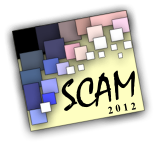- A tool paper is neither like a demo paper, nor like a research paper.
- It aptly and accurately describes a tool,
- Motivates its existence well (and relates it to what came before),
- Describes its architecture and explains its inner workings, and most appealing use cases.
- Describes experience gained in developing the tool.
- Does not necessarily compare with other tools (this is not a research paper)
The key criterion for acceptance is that the paper should make an original contribution that can benefit others engaged in designing and building tools for source code analysis and manipulation. The tool need not be entirely ready for deployment.
Authors are encouraged to reference supporting resources, including video demos of their tool, and reviewers may take this information into account as they review the paper. However, such materials will not become part of the permanent record of the conference, so the paper should stand on its own. In order to preserve reviewer anonymity, such materials should be hosted on an anonymous public source (e.g., youtube), or made available in such a way that the tools chair can download once and redistribute to reviewers. If authors would like to inform reviewers of additional information that does not appear in the paper, such information can be emailed to the Tools Chair Chanchal Roy at croy@cs.usask.ca. Authors of the accepted tool papers will be invited to present their tool at the conference. All the accepted tool papers will be published in the conference proceedings.
SUBMISSION:
Six pages IEEE format and can be submitted via EasyChair at
https://www.easychair.org/conferences/?conf=scamtool2012
Please follow the IEEE guidelines in preparing your manuscripts available at
http://www.ieee.org/conferences_events/conferences/publishing/templates.html
IMPORTANT DATES:
Abstract submission: May 28, 2012
Full tool paper submission: May 31, 2012
Notification: June 21, 2012
Camera Ready: July 06, 2012
Working conference: September 23 - 24, 2012
PROGRAM COMMITTEE:
Sanjay Bhansali, Google Inc., USA
Nils Göde, CQSE GmbH, Germany
Daqing Hou, Clarkson University, USA
Toshihiro Kamiya, Future University of Hakodate, Japan
Jiang Lingxiao, Singapore Management University, Singapore
Ravindra Naik, Tata Consultancy Services, India
Denys Poshyvanyk, College of William and Mary, USA
Romain Robbes, University in Chile, Chile
Chanchal Roy (Chair), University of Saskatchewan, Canada
Emad Shihab, Queen's University, Canada
